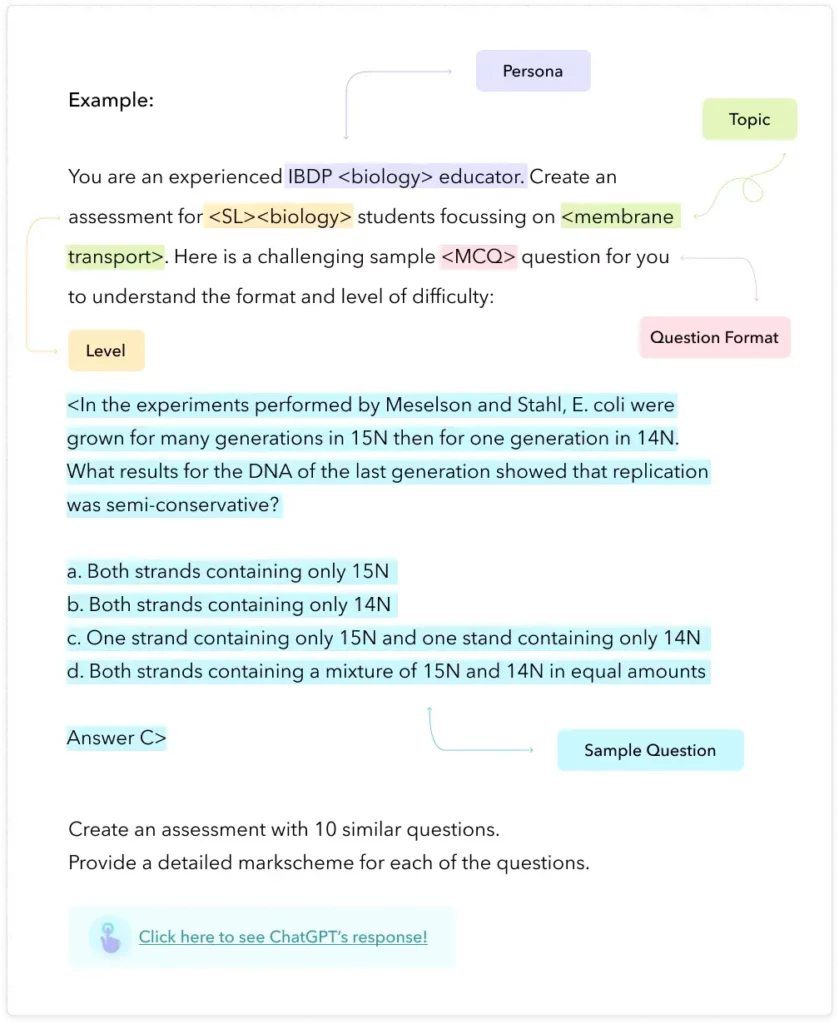Impact of AI on DP assessments
In the IBDP, AI is redefining traditional assessment and feedback methods for both educators and students. Educators can leverage AI to create robust exam-style assessments and to provide immediate, personalised feedback, a boon in larger classes. AI’s data-driven insights can also help educators tailor their teaching strategies and curriculum based on student learning patterns and performance.
On the student side, AI can significantly boost engagement and learning through interactive tools like adaptive quizzes, enhancing motivation and participation. It can provide instant, constructive feedback, aiding in the quick correction of their mistakes, and support the development of personalised learning pathways, aligning with each student’s unique pace and learning style.
This resource explores and demonstrates the possibilities of AI in creating assessments, offering feedback, and engaging your students.
Here’s what you’ll find inside:
- ChatGPT prompts for assessment and learning: Discover 20+ tried and tested prompts to create assessments, provide students with valuable feedback, and empower them to drive their learning. The prompts are tailored for both educators and students, making them a versatile tool for enhancing the educational experience.
- Assessment strategies and ethical guidance: Discover strategies and creative ideas for differentiating assessments, delivering effective feedback, engaging students with ChatGPT in meaningful ways, and ensuring the ethical use of AI in education.
As you navigate through this resource, keep an eye out for the ‘💡’ icon as it highlights helpful tips and insights about the prompt or its implementation. Lastly, you can dive into this resource at your own pace, or head straight to the prompt templates, designed to streamline your assessment strategies. We hope this guide helps you and your students reimagine IBDP assessments and feedback!💕
ChatGPT for assessment design
Crafting AI-driven exam-style assessments
If you’re struggling to find exam papers that students haven’t already solved and are spending hours creating exam papers from scratch, this section has you covered! We will focus here on how to design assessments that mirror the rigour and format of IBDP exams.
Let’s start by unpacking the key elements for constructing an assessment prompt:
- Persona: Define the role you want ChatGPT to assume. This helps the AI generate content aligned with the pedagogical standards of the IBDP.
- Level: Indicate whether your students are SL or HL to ensure the assessment has the right degree of depth and difficulty.
- Topic: Decide which topic or topics you want the assessment to focus on.
- Question format: State the desired format for the questions, such as multiple-choice, short answer, essay, data analysis, etc.
- Sample questions: Include sample questions from a past paper to guide ChatGPT in getting the format, question style, and length right.
- Markscheme: If you prompt it, ChatGPT will provide you with a markscheme!
Here is a template that incorporates all key elements in one prompt:
“You are an experienced IBDP <subject> educator. Create an assessment for <SL/HL><subject> students focussing on <topic>. Here is a challenging sample <question format> question for you to understand the format and level of difficulty: <sample question>.
Create an assessment with <number> similar questions and make sure that you follow the standard format for IBDP <subject> <question format> questions. Provide a detailed markscheme for each of the questions.”
Using the above template, you can seamlessly input the desired persona, level, sample questions, and topic to generate an assessment task for your students.

A few important points to keep in mind:
- The quality of output is influenced by the version of ChatGPT you use. For instance, ChatGPT 4 typically provides more refined results compared to its predecessor, 3.5.
- When working with ChatGPT 3.5, introduce marking rubrics or students’ work one at a time to obtain the most cohesive and detailed outputs.
- Even when you specify a word count for an assessment, it may not always meet your requirements. Don’t hesitate to correct the bot!
- For Group 2 subjects, be specific in your prompt. ChatGPT may not always equate Language B with a foreign language. Mention the proficiency level (e.g., A2 to B1 for ab initio, B1 or B2 for SL, and B2 or C1 for HL) to get the most accurate lesson plans.
- Assessment formats vary among DP subjects. When creating prompts for IBDP-style assessments, you might need to adjust the elements – not all elements are necessary for every subject.
- You may find it challenging to create papers where supplementary material is required (like maps in geography, graphs in economics or diagrams in science).
- The beauty of ChatGPT lies in its interactive nature. Don’t hesitate to ask follow-up questions to refine your assessments.

Creating in-class assessments
As assessment always begins in the classroom, let’s focus on how to use AI to design meaningful in-class assessment tasks. Whether you are evaluating student understanding of a topic or honing the vital skills necessary to ace the DP exams, this section provides insights and actionable prompts for incorporating AI seamlessly into your teaching approach.
Prompts to check for understanding
This section offers prompts to design a variety of engaging tasks to gauge your students’ understanding of key concepts, providing you with unique approaches to quick formative assessments.
Here are five prompts to create:
Cloze exercises
You are an experienced IBDP <subject> educator. Create a cloze exercise to assess students’ understanding of <topic>.
Exit ticket activities
You are an experienced IBDP <subject> educator. Create a 5-minute exit ticket activity to assess students’ understanding of <topic>.
Escape room assessments
You are an experienced IBDP <subject> educator. Create an escape room assessment task on <topic> to test students’ understanding of the topic.
Misconception checks activities
You are an experienced IBDP <subject> educator. Create an assessment activity based on <number> misconceptions to check students’ understanding of <topic>.
Other assessment methods
You are an experienced IBDP <subject> educator. Brainstorm five alternative assessment methods to assess students’ understanding of <topic>.
Prompts to assess subject-specific skills
Each IBDP subject formally assesses a distinct set of skills, as detailed in the subject guides. Tailoring assessments to develop these specific skills — such as critical thinking, scientific knowledge, and research skills — not only aligns with curriculum standards but also aids in developing ATL-focused assessments.
Here are two prompts to get you started:
Prompt to assess subject-specific skills
You are an experienced IBDP <subject> educator. Create a <number>-minute activity to test students’ application of <skill> in the context of the topic <topic>.
Prompt to create stimulus-based activities
You are an experienced IBDP <subject> educator. Suggest an assessment task for <SL/HL> students based on a stimulus that will assess their application of <topic>.
Prompts to create differentiated assessments
Differentiating assessments is crucial because it acknowledges and caters to the individual needs of students, thereby enhancing learning by addressing diverse abilities. AI is particularly effective in customising assessments, ensuring that each student receives support specifically tailored to their unique learning requirements. In this section, we have created five prompts to ensure that your students receive tailored support.
Prompt to scaffold age-appropriate reading (ESL)
You are an experienced IBDP <subject> educator. Rewrite the following resource for a student with a reading age of <age> years old. Produce a list of keywords with simple definitions to go with the text as well as a simple summary of the resource.
<insert material here>
Prompt to support reading skills (ESL)
You are an experienced IBDP <subject> educator. Generate a set of vocabulary exercises and comprehension questions based on the following resource to help students with a low level of English to further their understanding of the topic.
<insert material here>
Prompt to create differentiated tasks
You are an experienced IBDP <subject> educator. Create three differentiated tasks (one easy, one medium and one hard) for <SL/HL> students to assess their understanding of the <topic>.
Prompt to create scaffolding templates for IAs/EE
You are an experienced IBDP <subject> educator. Write a scaffolding template with instructions on sections of the IB <extended essay/subject internal assessment>, with explicit instructions on language choices and argumentation, for an <extended essay/internal assessment> in <subject>.
💡 For the EE, ChatGPT may provide a section for the abstract which is no longer a requirement. Don’t hesitate to correct it! It may also advise students to include their names and candidate numbers, which should not be the case: IA and EE submissions must be anonymous!
ChatGPT for feedback
Here, we’ll guide you on developing prompts that lead to insightful and constructive feedback from ChatGPT, fostering your students’ development. While ChatGPT doesn’t replace your expert judgement, it can significantly ease your workload!
Below are the key elements for constructing a feedback prompt:
- Persona: Define the role you want ChatGPT to assume. This helps the AI generate content aligned with the pedagogical standards of the IBDP.
- Task instructions: Include details of the task your students have completed, providing context for the assessment.
- Student work: Paste the student work you wish to evaluate. For better accuracy, it’s recommended to paste student responses individually.
- Rubric: Provide the details of your marking rubric to guide ChatGPT in aligning its feedback with your assessment criteria.
💡Remember to anonymise the students’ work! Do not include any personal details of the students (names, etc.).
Here is a template that incorporates all key elements in one prompt:
“You are an experienced IBDP <subject> educator. You have assigned the following assessment task to your students: <paste instructions here>.
Below is the work submitted by a student:
<paste student work here>
Can you provide feedback that identifies how the student has met the requirements of the marking rubric?
Below is the marking rubric:
<paste marking rubric here>“
💡 For more accuracy, you can paste a marked example to provide ChatGPT with a clear marking standard.
Here are two additional templates illustrating various methods of providing feedback and feedforward to your students, helping them grow and improve in their learning journey.
Prompt to give feedback: 3 stars and a wish
You are an experienced IBDP <subject> educator. You have given your students this assessment task: <paste instructions here>.
Below is the work submitted by a student. Can you analyse this piece of work and provide formative feedback in the format of ‘3 stars and a wish’?
<paste student response here>
Prompt to share feedforward strategies
You are an experienced IBDP <subject> educator. You have assigned the following assessment task to your students: <paste instructions here>.
Below is the work submitted by a student. Can you analyse this piece of work and provide feedforward to this student?
<paste student response here>
ChatGPT for student engagment
Our students are using ChatGPT, whether we like it or not. In this section, let’s explore how they can use AI as a meaningful tool to support their learning while fostering self-management and reflection skills.
💡 The following are student-facing prompts that you can share with your class for revision or as homework tasks
ChatGPT: Every student’s study buddy
ChatGPT can facilitate a self-directed, personalised learning experience, empowering students to take charge of their study path. Encourage your students to use these prompts to engage with ChatGPT for creating efficient revision materials and adaptive quizzes across various subjects.
Prompt to create revision flashcards
I am an IBDP <subject> <HL/SL> student. Create <number> revision flashcards to support my revision of <topic> based on the following information.
<copy paste lesson information>
Prompt to create information summaries
I am an IBDP <subject> <HL/SL> student. Create a summary of the key information I need to remember using the information provided below.
<copy paste lesson information>
Prompt to generate adaptive MCQs
You are an IBDP <subject> educator and I am an IBDP <subject> <HL/SL> student. Create an adaptive and interactive quiz that increases or decreases in difficulty based on my responses, on <topic>. The quiz should be <number> questions in total and once the quiz is over, please provide me with a list of my strengths and weaknesses.
Prompt to generate adaptive short-answer questions
You are an IBDP <subject> educator and I am an IBDP <subject> <HL/SL> student. Create an adaptive and interactive set of short-answer questions that increase or decrease in difficulty based on my responses on <topic>. There should be <number> questions in total and once they are over, please provide me with a list of my strengths and weaknesses.
ChatGPT: A student’s dialogue partner
ChatGPT can mimic a wide range of personalities, from book characters to scientists, offering a unique and interactive learning tool for DP students. Below are some group-specific examples you can share with your students.
- Group 1 (Language and literature): ChatGPT can assume the roles of various authors or characters, enabling students to delve deeper into literary texts through interactive discussions.
- Group 2 (Language acquisition): As a conversational partner in the target language, ChatGPT offers students valuable speaking practice, acting as a native speaker to enhance language fluency.
- Group 3 (Individuals and societies): In subjects like History, ChatGPT can role-play as historical figures or experts, fostering critical engagement and a deeper understanding of historical events and perspectives.
- Group 4 (Sciences): ChatGPT can be a virtual lab assistant or any famous scientist, guiding students through experiment protocols, and data analysis, and offering support in scientific inquiries.
- Group 6 (The Arts): For creative projects, ChatGPT helps as a research assistant, suggesting creative ideas and materials, and aiding in the planning of artistic endeavours.
- Core (TOK): In TOK, ChatGPT becomes a partner in Socratic dialogue, challenging students’ thinking and helping them construct and refine their arguments.
ChatGPT: A student’s quick feedback tool
While ChatGPT will help educators generate insightful feedback, it can also be used by students to get immediate feedback on their work and learning before they submit it to the teacher.
Prompt to check for grammatical errors
Assess the spelling and grammar of this piece of work. Make suggestions wherever you find the grammar and spelling to be inadequate.
<copy and paste work here>
Prompt to get targeted feedback
I am an IBDP <subject> <SL/HL> student. I have recently written a <response/essay/IA, etc.>. Below is my work. Can you provide me with feedback on <the accuracy of my facts/the structure of my response/the quality of my language, etc.>?
<paste work here>
Ethical use of ChatGPT
The ethical and responsible use of ChatGPT in the classroom requires understanding and adherence to certain guidelines. Schools may have different policies regarding the use of AI tools for both teachers and students. Students must be aware of the ethical limits of using AI to support their work. When submitting work to the IB, using AI tools is permissible, but students must reference these tools just as they would any other source in their work. This section provides direction for educators and students to responsibly navigate the use of ChatGPT.
Academic malpractice
Failing to mention the use of ChatGPT in an IB submission could be construed as academic malpractice, potentially leading to the student losing their Diploma. While tools like Turnitin are available to detect academic misconduct, teachers are often best equipped to identify it. Here is some basic guidance to avoid the unreferenced use of ChatGPT:
- Ensure the submitted work aligns in quality with the student’s other submissions.
- Regularly monitor and discuss the progress of the work with students.
- Conduct viva voces: if a student can articulate the content of their work, they are likely the author.
Citing and referencing AI
Similar to any other resource, AI tools must be appropriately referenced by students when used. Here is how students can appropriately reference the use of AI (using Harvard referencing):
In text: (NAME OF AI TOOL, year)
Example: (OpenAI ChatGPT, 2023) in brackets after the sentence/paragraph in which it was used.
Reference list: NAME OF AI TOOL, year.”[Title of the response or question]”. In ChatGPT. Retrieved on [date] from [URL]
Example: OpenAI, 2023. “Harvard Referencing for ChatGPT”. In ChatGPT. Retrieved on 22 November 2023, from https://chat.openai.com/share/202c452c-3993-4765-981d-45f358989b14
AI-generated pictures or graphs must be referenced similarly!
Recognising AI’s boundaries
It is crucial for educators to clearly articulate the limitations of AI to students:
- AI can be biased. At the end of the day, it relies on information gathered from the Internet, where certain communities or languages are underrepresented.
- AI can be wrong. While it is continually improving, it sometimes generates inaccurate information and has been known to invent facts and people.
- The quality of information generated by ChatGPT is only as good as the prompt provided by the user. It is therefore important to teach students the art of crafting good prompts.
- AI’s writing style can often seem unnatural. Although this can be mitigated with careful prompting, it may not fully capture the authenticity of students’ voices.
- AI, especially ChatGPT, may struggle to maintain output quality with excessively long prompts. It works better with shorter chunks of text.
Now that we’ve explored AI’s role in assessments and feedback, let’s not forget that AI can also be a valuable tool for creating inquiry-based lesson plans. If you’re looking for practical prompts to integrate the core, ATLs, and more into your lesson planning process, be sure to check out our resource 20+ ChatGPT prompts for effective IBDP lesson planning. Like any other learning tool, AI should be used selectively and critically, and this resource can guide you in doing so.















